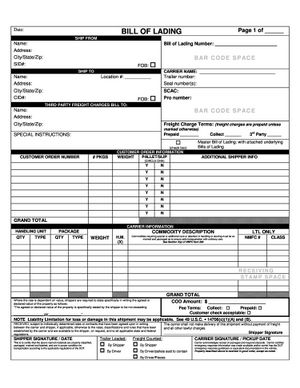Bill of Lading (BOL) (Customs Glossary)
| This article is part of the Customs Glossary Guide |

In the realm of North American highway trade, a Bill of Lading (BOL) is a crucial document that serves as a contract, receipt, and record of the transportation of goods between a shipper, carrier, and consignee. The Bill of Lading plays a pivotal role in facilitating the movement of goods across borders, providing essential information and legal protection for all parties involved in the transportation process. This article provides a comprehensive definition of the Bill of Lading in North American highway trade and explores the scenarios in which this document is utilized.
What is a Bill of Lading (BOL)?
A Bill of Lading is a legally binding document issued by a carrier (such as a trucking company) to acknowledge the receipt of goods for transportation. It serves as evidence of the contract of carriage between the shipper (the party sending the goods) and the carrier (the party responsible for transporting the goods). The Bill of Lading also acts as a receipt, indicating that the goods have been received in good condition for transport. This document plays a critical role in the logistics chain, ensuring transparency, accountability, and legal protection for all parties involved in the shipment process.
Scenarios in Which the Bill of Lading is Used:
Goods Transportation:
Scenario: A company based in Country A wants to ship goods to a customer located in Country B through a trucking company operating in both countries. Usage of BOL: The shipper provides a Bill of Lading to the trucking company, detailing the type, quantity, and condition of the goods. The carrier then issues its own Bill of Lading as a receipt and proof of the goods' pickup and assumes the responsibility for their safe transportation to the consignee in Country B.
Cross-Border Trade:
Scenario: A manufacturing company in the United States wants to export its products to Canada using a cross-border trucking service. Usage of BOL: The U.S. exporter prepares a Bill of Lading, which specifies the goods being shipped, their value, and the terms of the contract with the Canadian carrier. The carrier issues its own Bill of Lading, assuming the legal responsibility for the transportation and delivery of the goods to the Canadian consignee.
Legal Protection and Proof of Ownership:
Scenario: A supplier delivers goods to a warehouse for storage before they are dispatched to multiple retail outlets. Usage of BOL: The supplier issues a Bill of Lading to the warehouse operator, confirming the transfer of ownership and legal liability for the goods. This document safeguards the supplier's interests and ensures that the correct quantity and condition of goods are maintained while in storage.
Freight Payment and Insurance:
Scenario: An international freight forwarder arranges the transportation of goods from a factory in Mexico to a distribution center in the United States. Usage of BOL: The freight forwarder provides a Bill of Lading to the factory as proof of shipment and the contractual arrangement with the carrier. Additionally, the Bill of Lading assists in calculating freight charges, helps in the resolution of disputes, and is often used as evidence for insurance claims in case of loss or damage during transit.
Conclusion
The Bill of Lading is a fundamental document in North American highway trade that serves as a contract, receipt, and record of the transportation of goods between shippers, carriers, and consignees. By providing essential information and legal protection, the Bill of Lading ensures smooth and transparent logistics operations, fostering trust and efficiency in cross-border trade within the North American region.
